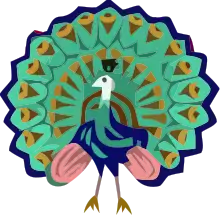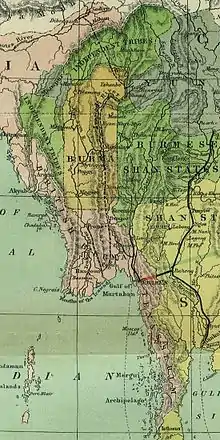Lower Myanmar
Lower Burma (Burmese: အောက်မြန်မာပြည်, also called Lower Myanmar) is a geographic region of Burma (Myanmar) and includes the low-lying Irrawaddy delta (Ayeyarwady, Bago and Yangon Regions), as well as coastal regions of the country (Rakhine and Mon States and Tanintharyi Region).
| History of Myanmar |
|---|
 |
|
|
|
|

In the Burmese language, people originating from Upper Burma are typically called a-nya-tha for men and a-nya-thu for women, whereas those from Lower Burma are called auk tha (အောက်သား) for men and auk thu for women.[1]
Historically, Lower Burma referred to the part of Burma annexed by the British Empire after the end of the Second Anglo-Burmese War in 1852,[2] plus the former kingdom of Arakan and the territory of Tenasserim which the British had taken control of in 1826 through the Treaty of Yandabo.[3] Lower Burma was centred at Rangoon, and composed of all of the coast of modern Burma, and also the lower basin of the Irrawaddy River, including Prome. Until the early 19th century, Lower Burma was predominantly populated by the Mon and Karen tribes and was a historical stronghold of the Mon people.
References
- Houtman, Gustaaf (1990). Traditions of Buddhist Practice in Burma. Research Institute for Languages and Cultures of Asia and Africa (ILCAA). p. 266.
In the Burmese language it is common to distinguish between 'Lower (Burma) Person' (auk-tha for men, and auk-thu for women), and 'Upper (Burma) Person'...
- Mya Than (1992). Myanmar's External Trade: An Overview in the Southeast Asian Context. Institute of Southeast Asian. p. 7. ISBN 98-130-1613-2.
- James Stuart Olson & Robert Shadle (1996). Historical Dictionary of the British Empire, Volume 1. Greenwood Publishing Group. p. 214. ISBN 03-132-9366-X.
